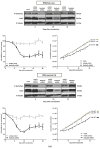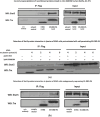Stat5 Exerts Distinct, Vital Functions in the Cytoplasm and Nucleus of Bcr-Abl+ K562 and Jak2(V617F)+ HEL Leukemia Cells
- PMID: 25809097
- PMCID: PMC4381271
- DOI: 10.3390/cancers7010503
Stat5 Exerts Distinct, Vital Functions in the Cytoplasm and Nucleus of Bcr-Abl+ K562 and Jak2(V617F)+ HEL Leukemia Cells
Erratum in
-
Correction: Weber et al. Stat5 Exerts Distinct, Vital Functions in the Cytoplasm and Nucleus of Bcr-Abl+ K562 and Jak2(V617F)+ HEL Leukemia Cells. Cancers 2015, 7, 503-537.Cancers (Basel). 2025 May 23;17(11):1754. doi: 10.3390/cancers17111754. Cancers (Basel). 2025. PMID: 40445629 Free PMC article.
Abstract
Signal transducers and activators of transcription (Stats) play central roles in the conversion of extracellular signals, e.g., cytokines, hormones and growth factors, into tissue and cell type specific gene expression patterns. In normal cells, their signaling potential is strictly limited in extent and duration. The persistent activation of Stat3 or Stat5 is found in many human tumor cells and contributes to their growth and survival. Stat5 activation plays a pivotal role in nearly all hematological malignancies and occurs downstream of oncogenic kinases, e.g., Bcr-Abl in chronic myeloid leukemias (CML) and Jak2(V617F) in other myeloproliferative diseases (MPD). We defined the mechanisms through which Stat5 affects growth and survival of K562 cells, representative of Bcr-Abl positive CML, and HEL cells, representative for Jak2(V617F) positive acute erythroid leukemia. In our experiments we suppressed the protein expression levels of Stat5a and Stat5b through shRNA mediated downregulation and demonstrated the dependence of cell survival on the presence of Stat5. Alternatively, we interfered with the functional capacities of the Stat5 protein through the interaction with a Stat5 specific peptide ligand. This ligand is a Stat5 specific peptide aptamer construct which comprises a 12mer peptide integrated into a modified thioredoxin scaffold, S5-DBD-PA. The peptide sequence specifically recognizes the DNA binding domain (DBD) of Stat5. Complex formation of S5-DBD-PA with Stat5 causes a strong reduction of P-Stat5 in the nuclear fraction of Bcr-Abl-transformed K562 cells and a suppression of Stat5 target genes. Distinct Stat5 mediated survival mechanisms were detected in K562 and Jak2(V617F)-transformed HEL cells. Stat5 is activated in the nuclear and cytosolic compartments of K562 cells and the S5-DBD-PA inhibitor most likely affects the viability of Bcr-Abl+ K562 cells through the inhibition of canonical Stat5 induced target gene transcription. In HEL cells, Stat5 is predominantly present in the cytoplasm and the survival of the Jak2(V617F)+ HEL cells is impeded through the inhibition of the cytoplasmic functions of Stat5.
Figures
















Similar articles
-
Thymoquinone Induces Downregulation of BCR-ABL/JAK/STAT Pathway and Apoptosis in K562 Leukemia Cells.Asian Pac J Cancer Prev. 2021 Dec 1;22(12):3959-3965. doi: 10.31557/APJCP.2021.22.12.3959. Asian Pac J Cancer Prev. 2021. PMID: 34967577 Free PMC article.
-
Inhibition of Bcr-Abl kinase activity by PD180970 blocks constitutive activation of Stat5 and growth of CML cells.Oncogene. 2002 Dec 12;21(57):8804-16. doi: 10.1038/sj.onc.1206028. Oncogene. 2002. PMID: 12483533
-
BCR-ABL but not JAK2 V617F inhibits erythropoiesis through the Ras signal by inducing p21CIP1/WAF1.J Biol Chem. 2010 Oct 8;285(41):31774-82. doi: 10.1074/jbc.M110.118653. Epub 2010 Jul 27. J Biol Chem. 2010. PMID: 20663870 Free PMC article.
-
BCR-ABL affects STAT5A and STAT5B differentially.PLoS One. 2014 May 16;9(5):e97243. doi: 10.1371/journal.pone.0097243. eCollection 2014. PLoS One. 2014. PMID: 24836440 Free PMC article.
-
JAK of all trades: JAK2-STAT5 as novel therapeutic targets in BCR-ABL1+ chronic myeloid leukemia.Blood. 2013 Sep 26;122(13):2167-75. doi: 10.1182/blood-2013-02-485573. Epub 2013 Aug 7. Blood. 2013. PMID: 23926299 Review.
Cited by
-
O-GlcNAcylation of STAT5 controls tyrosine phosphorylation and oncogenic transcription in STAT5-dependent malignancies.Leukemia. 2017 Oct;31(10):2132-2142. doi: 10.1038/leu.2017.4. Epub 2017 Jan 11. Leukemia. 2017. PMID: 28074064 Free PMC article.
-
Leelamine Modulates STAT5 Pathway Causing Both Autophagy and Apoptosis in Chronic Myelogenous Leukemia Cells.Biology (Basel). 2022 Feb 25;11(3):366. doi: 10.3390/biology11030366. Biology (Basel). 2022. PMID: 35336740 Free PMC article.
-
Investigation of fusion gene expression in HCT116 cells.Oncol Lett. 2017 Dec;14(6):6962-6968. doi: 10.3892/ol.2017.7055. Epub 2017 Sep 25. Oncol Lett. 2017. PMID: 29181107 Free PMC article.
-
Oxymatrine Attenuates Tumor Growth and Deactivates STAT5 Signaling in a Lung Cancer Xenograft Model.Cancers (Basel). 2019 Jan 7;11(1):49. doi: 10.3390/cancers11010049. Cancers (Basel). 2019. PMID: 30621055 Free PMC article.
-
Design, Synthesis, and Antitumor Evaluation of 4-Amino-(1H)-pyrazole Derivatives as JAKs Inhibitors.ACS Med Chem Lett. 2016 Aug 23;7(10):950-955. doi: 10.1021/acsmedchemlett.6b00247. eCollection 2016 Oct 13. ACS Med Chem Lett. 2016. PMID: 27774135 Free PMC article.
References
-
- Groner B., Hennighausen L. The versatile regulation of cellular events by jak-stat signaling: From transcriptional control to microtubule dynamics and energy metabolism. Horm. Mol. Biol. Clin. Investg. 2012;10:193–200. - PubMed
-
- Vafaizadeh V., Klemmt P., Brendel C., Weber K., Doebele C., Britt K., Grez M., Fehse B., Desrivieres S., Groner B. Mammary epithelial reconstitution with gene-modified stem cells assigns roles to stat5 in luminal alveolar cell fate decisions, differentiation, involution, and mammary tumor formation. Stem Cells. 2010;28:928–938. - PubMed
LinkOut - more resources
Full Text Sources
Other Literature Sources
Miscellaneous

